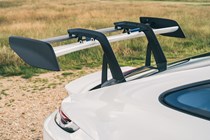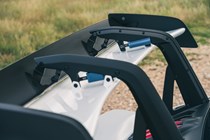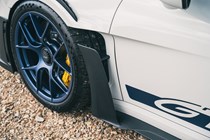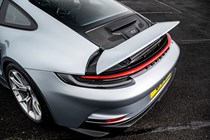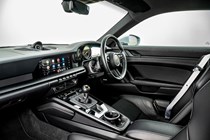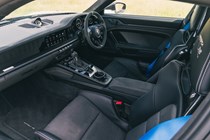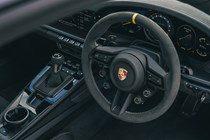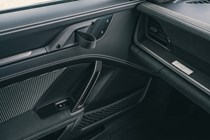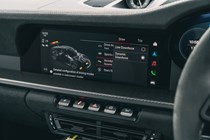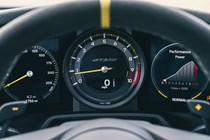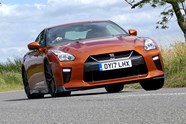
Porsche 911 GT3 (2021-2024) review
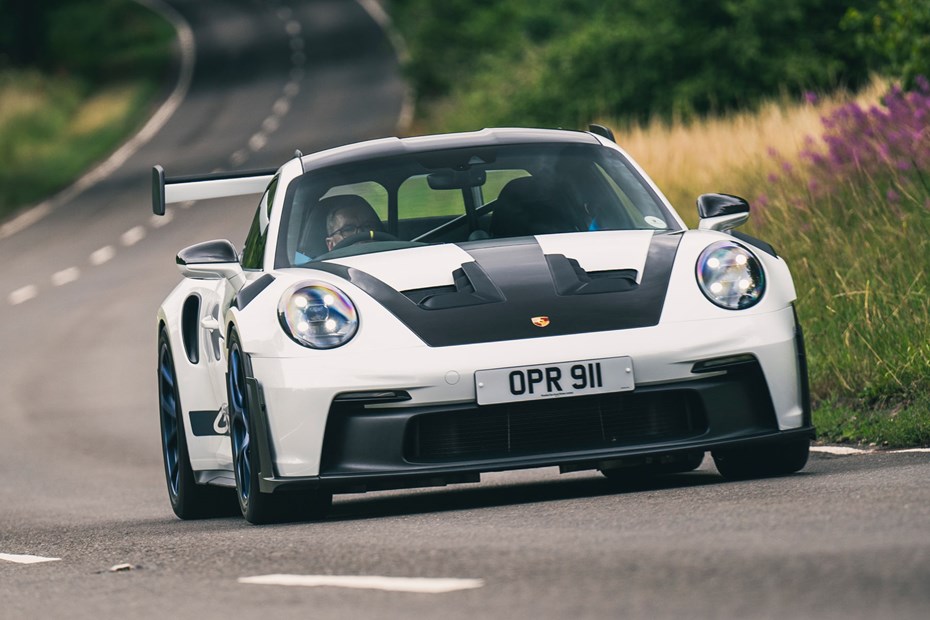
At a glance
| Price new | £198,145 |
|---|---|
| Used prices | £90,860 - £250,690 |
| Road tax cost | £620 |
| Insurance group | 50 |
Get an insurance quote with

|
|
| Fuel economy | 21.4 - 21.9 mpg |
| Miles per pound | 3.1 - 3.2 |
| Number of doors | 2 |
| View full specs for a specific version | |
Available fuel types
Petrol
Pros & cons
- Outstandingly involving to drive
- Huge performance on track
- Surprisingly road-friendly
- Can be intimidating at first
- Don't buy expecting refinement
- Image isn't for everyone
Porsche 911 GT3 (21-24) rivals
Overview
Every Porsche 911 is great to drive. But if you’re a serious driving enthusiast with plenty of money to spend then you’ll no doubt have considered the 911 GT3 and 911 GT3 RS. It’s no coincidence that these models share their name with the FIA GT3 racing category, as they are among the very closest things to racing cars with number plates that you can buy from a mainstream manufacturer.
And while they share plenty of parts with other 911s in the current 992 generation, there are some significant differences. Hence we’re treating these particular sports cars to this separate review.
As the racing relationship suggests, the 911 GT3 family is laser-focused on delivering high-performance. Not in terms of straight-line speed particularly – though they are certainly both very fast, the 911 Turbo and Turbo S accelerate faster and have higher maximum velocities. But rather in the way they make you, the driver, feel and in how quickly they can lap a racing circuit.
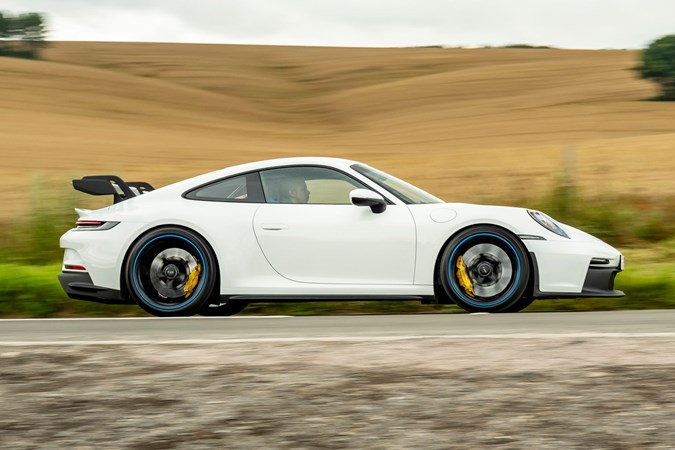
These are the rawest, most involving Porsche 911s, capable of changing direction and stopping in a manner that can quite literally take your breath away.
What’s the difference between the GT3 and GT3 RS?
The way they look does much of the explaining here.
The regular GT3 – if you can use the word regular about such a machine – is certainly extreme, but it is still intended to be a relatively road-friendly option for hardcore track day enthusiasts. As such, it’s even available with a Touring Pack.
Often known as the GT3 Touring (which was a standalone model in the previous 991-generation of Porsche 911), this ditches the big rear wing and adds classic silver exterior detailing to create a more subtle appearance without compromising too much in the corners. As with many 911s, there’s an active spoiler hidden in the engine cover that deploys at speed.

The GT3 RS, on the other hand, is the Keith Flint of performance cars. Like the late Prodigy front man, it glories in punky colours and spikey detailing.
The carbonfibre reinforced plastic (CFRP) front wings are flared, vented and carry an aerodynamic element right through onto the unique CFRP doors, which in turn feature bespoke, lightweight door handles. There’s an intake over the rear wheels and another slash cut behind, and Porsche has fitted a rear wing that stands twice the height of the normal GT3 item.
This is part of an active aerodynamics package intended to maximise downforce; there’s a button on the steering wheel to put it into a low-drag setting on the straights, just like a Formula 1 car. It’s wild, almost cartoonish, and leaves no doubt about this Porsche’s intentions.

Instead of the Touring Pack, GT3 RS buyers get the option of a Weissach Package, which adds a visible carbonfibre finish to front bonnet, roof and parts of the wing, and swaps a number of mechanical components for lighter CFRP items; the rollbar behind the seats is made from the same material for the first time, too.
Less obvious at a glance is the motorsport upgrade to the paddleshifters for the standard-fit PDK automatic gearbox, while all versions of the GT3 RS are the first 911 road cars to receive a single new centrally mounted radiator that does away with the triple radiators fitted on other variants, making more space for aerodynamic trickery. This is also a direct link to motorsport.
The GT3 RS costs approximately a third more than the GT3. A slight bump in power from 510hp to 525hp (thanks largely to revised camshafts) plus shorter gear ratios in the seven-speed PDK transmission means it accelerates faster, but also has a lower top speed. Consequently, it’s also noisier on the motorway.
What’s it like inside?
Neither version comes with rear seats. You can have a rollbar instead, as part of the no-extra-charge Clubsport Package, or just use the space for luggage. Ironically, anyone mad enough to be considering long-distance travel and weeks away in the GT3 RS needs to think seriously about this, as the luggage space that’s usually found under the bonnet is filled with radiator here.
The regular GT3 is otherwise not too far removed from the rest of the 911 range to look at in the cabin; the GT3 RS has been on a more extreme (that word again) weight-reduction programme, and gets straps instead of interior door handles, lighter door cards and less sound deadening. It also features additional circular switch pods on the steering wheel, but three of these only do something if you’re driving in Track mode – which we didn’t do much of on the A338.
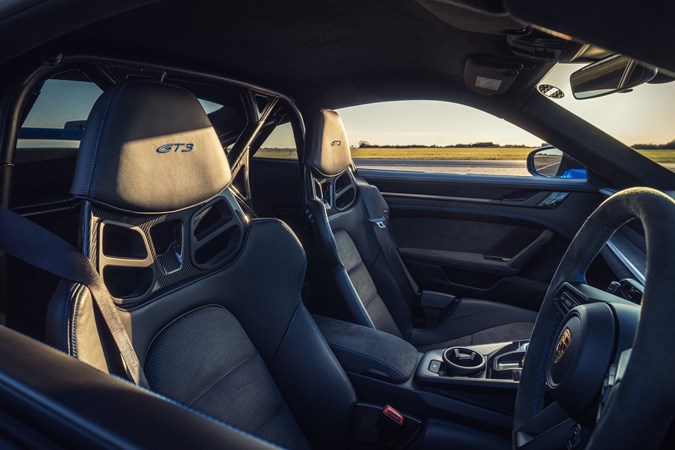
Both are otherwise thoroughly modern, with digital instrument clusters punctuated by the classic Porsche central rev counter (which remains a physical rather than virtual component), and slick touchscreen infotainment. PDK is standard on the GT3 and GT3 RS, and these days the central gear selector pretends to be a manual gearknob; the GT3 Touring Pack gets an actual six-speed manual transmission as part of its road-driver-centric brief.
It’s a no-cost option to swap the transmissions around in the GT3 and the Touring, but RS buyers can only have the PDK. Because it’s faster on track.
Comfort
If it’s comfort you’re after, you’ve probably come to the wrong place. While all variants of the GT3 can be ordered with multi-way adjustable ‘comfort’ sports seats, their character better suits the racing buckets that are fitted by default. These can be upgraded with 3D-printed inserts available in variable levels of hardness to ensure the committed enthusiast is supported as securely as possible.
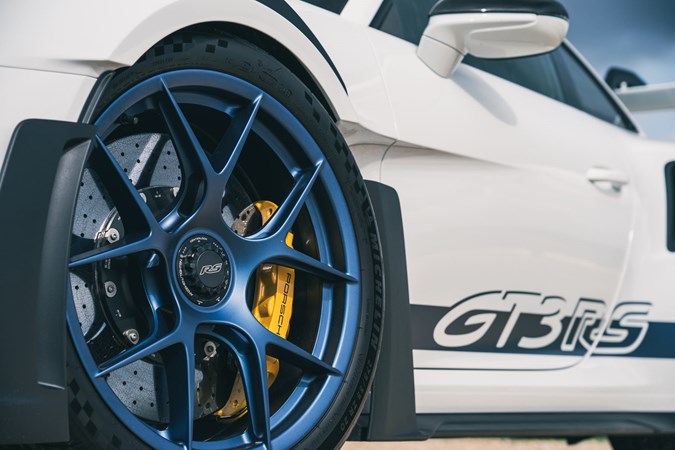
Reduced sound-insulation and lighter construction means GT3 models are also (much) noisier inside – and the 911 isn’t the quietest of cars in the first place. In the GT3 RS especially, occupants are beset with mechanical sounds from the engine and transmission, a sort of sizzling noise from even light application of the optional carbon-ceramic brakes and may initially be alarmed at the racket made by any loose material on the road surface being picked up and flung at the inside of the wheel arches. There’s more vibration and sensation as well.
This is all part of the excitement. But expect to end lengthier sessions with your ears ringing and possibly your entire body resonating (although wearing a helmet while driving on track will help, you’ll probably look a bit odd doing this on the way to the shops).
Inevitably, the suspension is also rather firm – but we’ll deal with that in the driving section below.
Safety
Euro NCAP doesn’t crash test 911s. And even if it did, the quest for driver purity means the GT3 range avoids over-complicating matters with many safety aids. You get a bunch of airbags, and that’s almost it.
That said, as already mentioned, you can have a rear rollbar in combination with some excellent bucket seats; a road-legal fire extinguisher system is available, too.
The traction and electronic stability control are state of the art, and the sheer dynamic prowess of these machines mean it’s almost as easy to get out of trouble as it was to get into it in the first place.
What’s it like to drive?
In the beginning, it all feels a bit much. As we said at the start, an ordinary 911 is a very fine thing indeed to punt along your favourite piece of road, and the additional quilted composure offered by one of those means that some drivers will not only be more comfortable driving them quickly they might actually be faster over the same stretch than they would be in a GT3.

For even the standard GT3 – let alone the more energetic GT3 RS – is a very lively thing to say the least. You are bombarded with feedback from the moment the wheels start turning. All that extra noise, the way the chassis and suspension enthusiastically reacts to the tarmac beneath you, the fury of a highly-tuned 4.0-litre non-turbocharged flat-six that revs to a lofty 9,000rpm; a fair degree of commitment is required to unleash even a small amount of everything a GT3 can give you.
Adding to this slight sense of otherness, GT3 models use racing-car derived double-wishbone front suspension, so anyone used to normal or previous-generation models of modern 911 may be taken slightly aback by the alteration in steering sensation this seems to exacerbate. The 911 is famous for many things, but especially the way its steering feels thanks to the weight of the engine pressing down on the rear rather than the front axle. In the GT3 this is still very much present, but also slightly… different.
The first time you fully engage the accelerator pedal and have to actively resist the impression the car is immediately trying to ping you into the hedge whenever it encounters a bump could be enough to put off some would-be customers entirely. Certainly, we’re aware of one independent suspension specialist that is doing a roaring trade calming down the handling of GT3 Touring models in particular so that customers feel better able to get to grips with them. Fortunately, there’s such a huge degree of adjustment available from the chassis that quite specific needs can be accommodated.

In the GT3 RS, you can even adjust the individual rebound and compression responses of the shock absorbers on the fly, as well as alter the behaviour of the rear differential – both features unlocked by the Track driving mode. For the sake of your sanity, we don’t recommend mucking about with this until you’ve got to grips with the car in Normal and Sport.
We digress. The important thing is that if you are one of those serious driving enthusiasts referenced in the intro, stick with it. Because there are few cars on earth that can give you the level of involvement and satisfaction available to the pilot of a 911 GT3. Curiously, it took us a little longer to dial into the GT3 Touring, but within a couple of hours we were belting seven kinds of hell out of the GT3 RS without feeling like we were over-driving it or in danger of being launched into the scenery.
Yes, these cars are firm – the harder Sports suspension setting lasted literally about 30 seconds on the road for us; it’ll make more sense on track – and no, you’re not likely to be hitting the 9k redline in public on a regular basis unless you’ve had all sense of self-preservation entirely removed. But goodness gracious do they make you feel like you’re part of the action, and once moving quickly their ability to absorb and deal with broken surfaces is quite remarkable.
The way they can not just carry speed but flick between left and right in the turns is utterly addictive (both variants come with rear-wheel steering, though it’s even more pronounced in the GT3 RS). The howl of the engine combined with the finger-click tempo of the PDK transmission makes even slowing down for traffic lights a joy. The all-encompassing mechanical assault becomes a symphony in time, and you’re soon staring at the nav screen looking for ever more twisting and diverting lanes to indulge in.

For all that, these are still cars that are happy enough to potter and won’t throw a strop in traffic. They are a little trickier to manoeuvre at very low speeds, but with a decent set of ear plugs and a reliable set of back exercises we reckon we could live with even the GT3 RS day-to-day. If nothing else, a swift go in one of those is enough to make the regular GT3 seem less outrageous – without detracting from its own immense capability.
What models and trims are available
We’ve been through the various derivatives of GT3 already. But know also that there’s an extensive options list, covering everything from lightweight magnesium wheels to bonkers paint (for the bodywork and the wheels), and increased aerodynamics from the Manthay Performance Kit.
On top of that, you can always go further with bespoke customisations via the Porsche Sonderwunsch programme. If you’ve got the money, there’s no limit.
What else should I know?
Like the sound of a GT3? Don’t assume that’s job done – it’s notoriously difficult to just walk into a dealer and order a special-item 911 like this, and often the build slots go to preferred customers. Usually those with a track-record of owning previous Porsches.
This partially explains why used examples often command very high prices. Some people are simply prepared to pay more money to jump the queue.

















